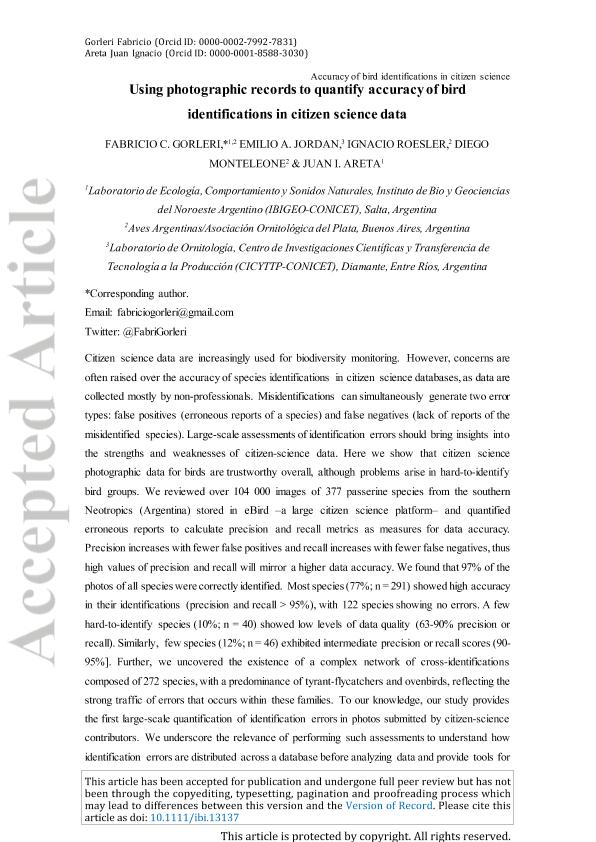Mostrar el registro sencillo del ítem
dc.contributor.author
Gorleri, Fabricio Carlos

dc.contributor.author
Jordan, Emilio Ariel

dc.contributor.author
Roesler, Carlos Ignacio

dc.contributor.author
Monteleone, Diego
dc.contributor.author
Areta, Juan Ignacio

dc.date.available
2023-07-24T19:42:44Z
dc.date.issued
2023-04
dc.identifier.citation
Gorleri, Fabricio Carlos; Jordan, Emilio Ariel; Roesler, Carlos Ignacio; Monteleone, Diego; Areta, Juan Ignacio; Using photographic records to quantify accuracy of bird identifications in citizen science data; Wiley Blackwell Publishing, Inc; Ibis; 165; 2; 4-2023; 458-471
dc.identifier.issn
0019-1019
dc.identifier.uri
http://hdl.handle.net/11336/205123
dc.description.abstract
Citizen science data are increasingly used for biodiversity monitoring. However, concerns are often raised over the accuracy of species identifications in citizen science databases, as data are collected mostly by non-professionals. Misidentifications can simultaneously generate two error types: false positives (erroneous reports of a species) and false negatives (lack of reports of the misidentified species). Large-scale assessments of identification errors should provide insights into the strengths and weaknesses of citizen science data. Here we show that citizen science photographic data for birds are trustworthy overall, although problems arise in hard-to-identify bird groups. We reviewed over 104 000 images of 377 passerine species from the southern Neotropics (Argentina) stored in eBird – a large citizen science platform – and quantified erroneous reports to calculate precision and recall metrics as measures for data accuracy. Precision increases with fewer false positives and recall increases with fewer false negatives; hence, high values of precision and recall will mirror a higher data accuracy. We found that 97% of the photos of all species were correctly identified. Most species (77%; n = 291) showed high accuracy in their identifications (precision and recall > 95%), with 122 species showing no errors. A few hard-to-identify species (10%; n = 40) showed low levels of data quality (63–90% precision or recall). Similarly, few species (12%; n = 46) exhibited intermediate precision or recall scores (90–95%). Further, we uncovered the existence of a complex network of cross-identifications composed of 272 species, with a predominance of tyrant flycatchers and ovenbirds, reflecting the strong traffic of errors that occurs within these families. To our knowledge, our study provides the first large-scale quantification of identification errors in photos submitted by citizen science contributors. We underscore the relevance of performing such assessments to understand how identification errors are distributed across a database before analysing data, and provide tools for citizen science stakeholders to direct more specific efforts toward species that need an improvement in data quality.
dc.format
application/pdf
dc.language.iso
eng
dc.publisher
Wiley Blackwell Publishing, Inc

dc.rights
info:eu-repo/semantics/openAccess
dc.rights.uri
https://creativecommons.org/licenses/by-nc-sa/2.5/ar/
dc.subject
ARGENTINA
dc.subject
EBIRD
dc.subject
FALSE NEGATIVES
dc.subject
FALSE POSITIVES
dc.subject
MISIDENTIFICATIONS
dc.subject
NEOTROPICS
dc.subject
NETWORK ANALYSIS
dc.subject
PASSERINES
dc.subject
PRECISION
dc.subject
RECALL
dc.subject.classification
Zoología, Ornitología, Entomología, Etología

dc.subject.classification
Ciencias Biológicas

dc.subject.classification
CIENCIAS NATURALES Y EXACTAS

dc.title
Using photographic records to quantify accuracy of bird identifications in citizen science data
dc.type
info:eu-repo/semantics/article
dc.type
info:ar-repo/semantics/artículo
dc.type
info:eu-repo/semantics/publishedVersion
dc.date.updated
2023-07-06T22:03:09Z
dc.journal.volume
165
dc.journal.number
2
dc.journal.pagination
458-471
dc.journal.pais
Reino Unido

dc.journal.ciudad
Londres
dc.description.fil
Fil: Gorleri, Fabricio Carlos. Consejo Nacional de Investigaciones Científicas y Técnicas. Centro Científico Tecnológico Conicet - Salta. Instituto de Bio y Geociencias del NOA. Universidad Nacional de Salta. Facultad de Ciencias Naturales. Museo de Ciencias Naturales. Instituto de Bio y Geociencias del NOA; Argentina
dc.description.fil
Fil: Jordan, Emilio Ariel. Provincia de Entre Ríos. Centro de Investigaciones Científicas y Transferencia de Tecnología a la Producción. Universidad Autónoma de Entre Ríos. Centro de Investigaciones Científicas y Transferencia de Tecnología a la Producción. Consejo Nacional de Investigaciones Científicas y Técnicas. Centro Científico Tecnológico Conicet - Santa Fe. Centro de Investigaciones Científicas y Transferencia de Tecnología a la Producción; Argentina
dc.description.fil
Fil: Roesler, Carlos Ignacio. Asociación Ornitológica del Plata; Argentina. Consejo Nacional de Investigaciones Científicas y Técnicas; Argentina
dc.description.fil
Fil: Monteleone, Diego. Asociación Ornitológica del Plata; Argentina
dc.description.fil
Fil: Areta, Juan Ignacio. Consejo Nacional de Investigaciones Científicas y Técnicas. Centro Científico Tecnológico Conicet - Salta. Instituto de Bio y Geociencias del NOA. Universidad Nacional de Salta. Facultad de Ciencias Naturales. Museo de Ciencias Naturales. Instituto de Bio y Geociencias del NOA; Argentina
dc.journal.title
Ibis

dc.relation.alternativeid
info:eu-repo/semantics/altIdentifier/url/https://onlinelibrary.wiley.com/doi/10.1111/ibi.13137
dc.relation.alternativeid
info:eu-repo/semantics/altIdentifier/doi/http://dx.doi.org/10.1111/ibi.13137
Archivos asociados
